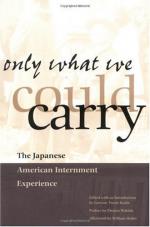|
This section contains 359 words (approx. 2 pages at 300 words per page) |

|
While many internees did their best to reproduce the communities they lived in on the Pacific shore, the corrosive nature of camp life soon became evident. The Japanese family unit began to break down as a result of the crowded lifestyle of the camps and frayed nerves easily succumbed to anger. Families no longer ate together in the mess hall atmosphere of the camps. Children preferred to eat with their more Americanized friends and older generation Issei retreated into their own groups.
The political divide between the Nisei and Issei solidified as controversial debates were introduced. In January 1943 the subject of military service was the cause of a great deal of tension between Nisei sons and Issei parents. In the wake of the attack on Pearl Harbor all Japanese Americans were classified 4-C by the U.S. Army. This was the same designation given to enemy aliens...
|
This section contains 359 words (approx. 2 pages at 300 words per page) |

|




